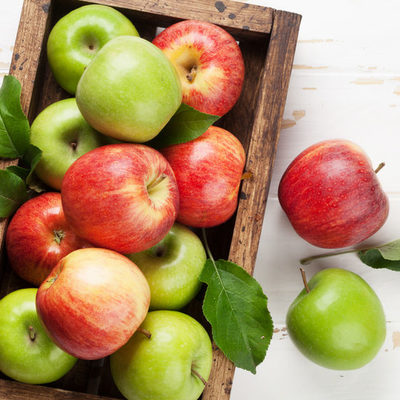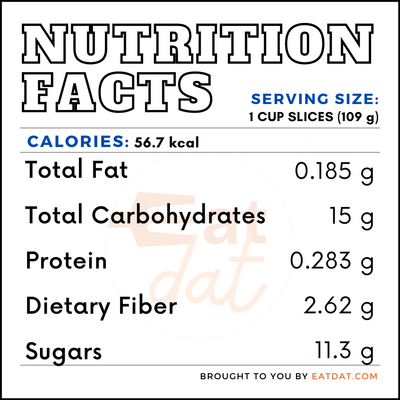
Apple
What is an Apple?
The apple is a round, tree fruit that grows in 7,500 different varieties around the world. This fruit can be eaten raw as a snack or cooked in sweet dishes like pie or savory dishes like salad. Apples possess many vitamins and nutrients, thereby being considered a healthy food.
The top 5 popular apple varieties, according to Farm Flavor, are:
- Gala
- Red Delicious
- Fuji
- Granny Smith
- Honey Crisp
Origin
Archaeologists have proof of apples being eaten as far back as 6,500 B.C. The domesticated apple (malus pumila) has genetically contributed to most modern-day hybrids of this fruit. While many believe that it originated in southeast Europe, extensive studies and research concluded that this fruit actually originated in Central Asia.
The Central Asian wild apple (malus sieversii) is native to the fruit forests in that area and is naturally variable in size, shape, flavor, and color. With such a varying gene pool, humans were able to propagate their favorite types and, in turn, domesticate the wild Central Asian species. Historians suggest that international trade with Asia on account of the Silk Roads may have been how the malus orientalis made it to Europe and, through hybridization, became the European wild apple (malus sylvestris).
Nutrition
One cup of apple slices contains a nutritional value of:

Apples are wholly nutritious, but their skin holds the majority of their vitamins. The fruit’s skin contains Vitamin C and most of its flavonoids, such as quercetin. Quercetin is a natural plant chemical that possesses anti-inflammatory and antioxidant properties. The rest of the apple is full of soluble and insoluble fiber. One type of fiber found in the fruit is pectin, which helps lower bad cholesterol (LDL) and prevents constipation.
Quercetin and pectin are the two main reasons why apples are considered healthy. Research shows that incorporating apples into your diet can help with:
- Cardiovascular health
- Type 2 diabetes
- Weight control
- Cancer
Commercial Production
In 2019, the U.S. produced 5,048 metric tons of apples. Apples are commercially produced in 36 of the 50 states. From the 2,500 varieties grown in the United States only 100 varieties are grown commercially. The top producers of this fruit around the world are China, the U.S., Turkey, Italy, and Poland.
Uses of Apples
Ranging in flavor from sweet to tart, the apple is a dessert and cooking fruit. Its texture varies from crunchy to crispy, making it ideal for various cooking or baking dishes, as well as being eaten raw. Varieties such as Braeburn, Granny Smith, and Jonagolds stay firm, crisp, and don’t become mushy at high temperatures, which means they are perfect for baking. Other varieties like Red, Golden Delicious, and Fuji are sweeter, softer, and more suitable for snacking.
Storing apples properly will help maintain their flavor, texture, and nutrients. If stored in a cold place, such as the crisper drawer of a refrigerator, they can stay fresh for one to two months. Because they are climacteric, this fruit begins to emit ethylene after being picked and, as a result, continues to ripen. Although they will still emit ethylene when refrigerated, the lower temperatures keep them from ripening too fast. These fruits should be stored separately as the ethylene they emit can cause other foods to ripen too quickly.
Recipes
“As American as Apple Pie” is the reason why these fruits are quintessential in the American diet. Here are a few popular recipes:
- Apple Pie
- Dutch Apple Pie
- Apple Cobbler
- Apple Sauce
- Cinnamon Apple Pork Chops
- Spiced Apple Cranberry Drink
References
“Apples.” The Nutrition Source, Harvard T.H. Chan School of Public Health, www.hsph.harvard.edu/nutritionsource/food-features/apples/.
“Plant 148, Malus Pumila Mill. (Rosaceae).” Oxford Plants 400, University of Plant Sciences, University of Oxford, https://herbaria.plants.ox.ac.uk/bol/plants400/Profiles/MN/Malus.
Mauricio, Rodney. “New Insight into the History of Domesticated Apple: Secondary Contribution of the European Wild Apple to the Genome of Cultivated Varieties.” National Center for Biotechnology Information, U.S. National Library of Medicine, 10 May 2012, https://www.ncbi.nlm.nih.gov/pmc/articles/PMC3349737/.
“Apple Facts.” University of Illinois Extension, University of Illinois, https://web.extension.illinois.edu/apples/facts.cfm.
